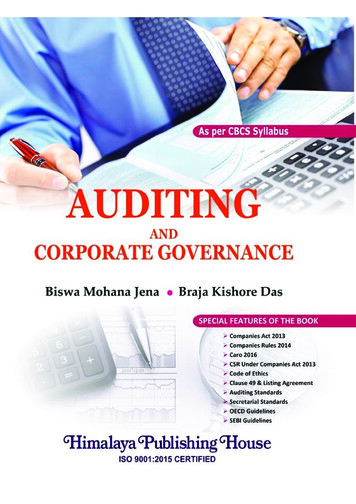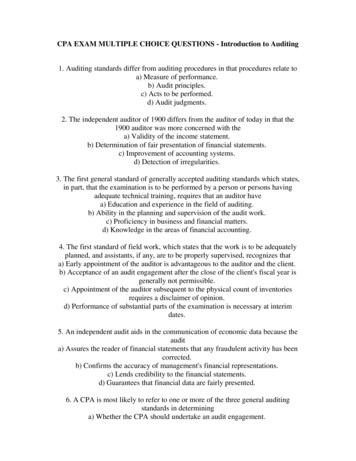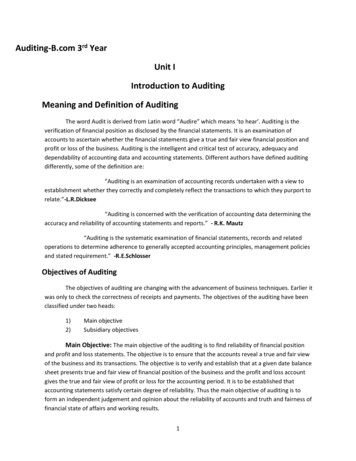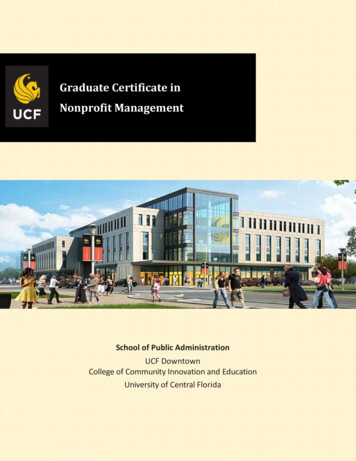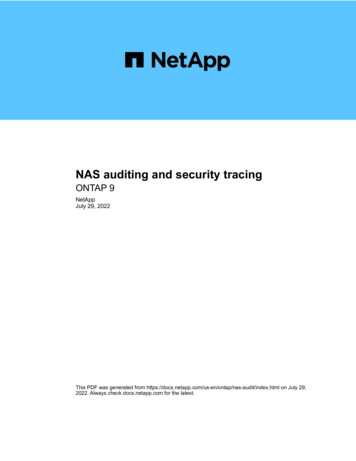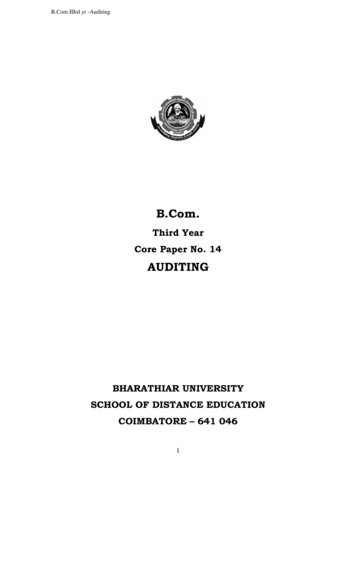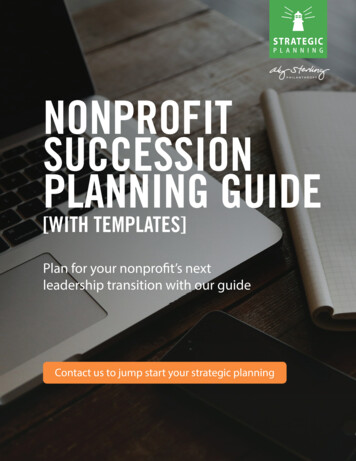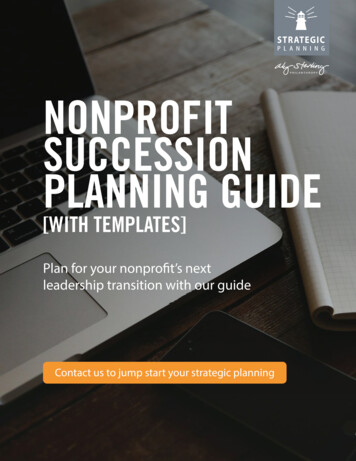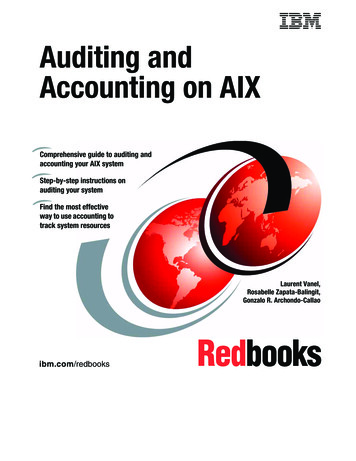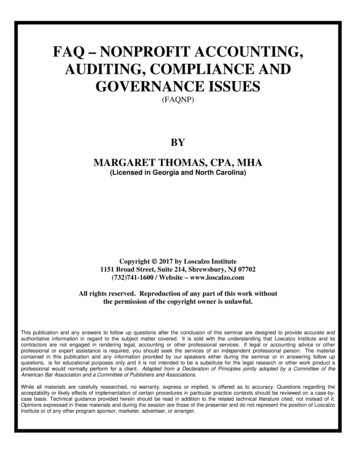
Transcription
FAQ – NONPROFIT ACCOUNTING,AUDITING, COMPLIANCE ANDGOVERNANCE ISSUES(FAQNP)BYMARGARET THOMAS, CPA, MHA(Licensed in Georgia and North Carolina)Copyright 2017 by Loscalzo Institute1151 Broad Street, Suite 214, Shrewsbury, NJ 07702(732)741-1600 / Website – www.loscalzo.comAll rights reserved. Reproduction of any part of this work withoutthe permission of the copyright owner is unlawful.This publication and any answers to follow up questions after the conclusion of this seminar are designed to provide accurate andauthoritative information in regard to the subject matter covered. It is sold with the understanding that Loscalzo Institute and itscontractors are not engaged in rendering legal, accounting or other professional services. If legal or accounting advice or otherprofessional or expert assistance is required, you should seek the services of an independent professional person. The materialcontained in this publication and any information provided by our speakers either during the seminar or in answering follow upquestions, is for educational purposes only and it is not intended to be a substitute for the legal research or other work product aprofessional would normally perform for a client. Adapted from a Declaration of Principles jointly adopted by a Committee of theAmerican Bar Association and a Committee of Publishers and Associations.While all materials are carefully researched, no warranty, express or implied, is offered as to accuracy. Questions regarding theacceptability or likely effects of implementation of certain procedures in particular practice contexts should be reviewed on a case-bycase basis. Technical guidance provided herein should be read in addition to the related technical literature cited, not instead of it.Opinions expressed in these materials and during the session are those of the presenter and do not represent the position of LoscalzoInstitute or of any other program sponsor, marketer, advertiser, or arranger.
Loscalzo CoursesAccounting and Auditing Programs8-Hour Programs 2017 FASB and AICPA Update NEW! (FAU) Accounting for New Revenue Standard (ANR) Analyzing Financial Statements, Including Techniques for Cash Flow Analysis (AFS) Compilation and Review Practice Guide (CRP) Deceptive Revenue Recognition and Other Accounting Techniques– Recognizing the Warning Signs (DRR) Disclosure – The Key to Financial Statements (DKFS) FAQ – Accounting and Auditing (FAQAA) Fraud for Industry (FRAUDI) Fraud for the CPA (FRAUDC) GAAP for Industry (GAAPI) GAAP for the CPA (GAAPC) Improve Your Accounting and Finance Teams’ Effectiveness (IAF) Reviewing Documentation Effectively (RDE) Risk-Based Audit Standards: Effective Utilization (RBA) Special Purpose Frameworks (SPF) Tax Practitioner’s Guide to Accounting and Reporting Issues (TPG) Understanding and Testing Internal Control (UTIC)4-Hour Programs Accounting and Auditing Updates NEW! (AAU4) Accounting for New Revenue Standard (ANR4) Analytical Procedures Workshop (APW4) Analyzing Financial Statements, Including Techniques for Cash Flow Analysis (AFS4) Attestation Standards NEW! (AS4) Compilation and Review Practice Guide (CRP4) Deceptive Accounting Practices (DAP4) External Fraud (EF4) Fair Value: Measurement (FV4) FAQ – Audit Issues (FAQAI4) FAQ – GAAP Financial Statements (FAQG4) Financial Reporting Framework for Small- and Medium-Sized Entities (FRF4) Improve Your Accounting and Finance Teams’ Effectiveness (IAF4) Internal Fraud (IF4) Lease Accounting in Transition (LAT4) Pitfalls and Problems in Financial Statement Disclosures (PPF4) Planning Cost Efficient and Effective Audits (PCE4) Tax Basis and Other Special Purpose Frameworks Presentations (SPF4)2-Hour Programs Accounting for Income Taxes (AIT2) Analytical Procedures for Reviews and Audits (APR2) Analyzing Financial Statements – A Guide (AFS2) Dangers of Improper Revenue Recognition (DIR2) Derivative and Hedging (DH2) Efficiency and Effectiveness in Documentation Review (EED2) FASB Updates NEW! (FASB2)
Meeting Documentation Requirements in Your Workpapers (MDR2)Nonstatistical Sampling for Efficient Audits (NSE2)Peer Review Deficiencies – How to Solve Them? (PRD2)Recent Compilation and Review Issues (CRP2)Related Party Transactions – A Recurring Issue (RPT2)Statement of Cash Flows (SCF2)Variable Interest Entities and Related Party Leases (VIE2)Governmental and Not-For-Profit Programs8-Hour Programs Compliance Auditing from Start to Finish (CAS) Compliance Auditing: Questions from the Field (CAQ) Essentials of Nonprofit Auditing (ENA) FAQ – Nonprofit Accounting, Auditing, Compliance and Governance Issues (FAQNP) Governmental Update (GU) Nonprofit, Government and Compliance Update (NGCU) Nonprofit Industry Update and GAAP Refresher (NIU)4-Hour Programs Identifying and Addressing the Risk of Fraud in Nonprofit Organizations (IAR4)Employee Benefit Plans Programs8-Hour Programs 2017 Current Practice Issues and Update for Audits of Employee Benefit Plans NEW! (CPI) Audits of Defined Contribution Pension Plans (Emphasizing 401k Plans) (ADC) FAQ – Employee Benefit Plan Accounting and Auditing (FAQEBP)Professional Ethics Programs4-Hour Programs Professional Ethics for CPAs (ETHICS4) Tax Practitioner Responsibilities and Ethics (TAXE4)Professional Development Program8-Hour Programs Business Communication (BC)Tax Programs16-Hour Programs Tax Staff Training (2-Day) – Advanced Issues (TSTA) Tax Staff Training (2-Day) – Business (TSTB) Tax Staff Training (2-Day) – Individual (TSTI)8-Hour Programs Accounting Methods as a Tax Planning Service: Filing Form 3115 to Save Taxes (AMTP) Advanced Tax Practice (ATP) Advanced Tax Update for Experienced Practitioners (ATU) Church and Minister Taxation (CMT) Assisting Survivors: CPA’s Role in the Decedent’s Estate (ASDE) Business & Industry Tax Update (BITU) C Corporation: Advanced (CCA)
Construction Contractors: Special Tax and Accounting Considerations (CCST)Corporate Taxation: Subchapter C for C Corporation and S Corporation (CTSC)CPA Succession Planning (CPAS)Current Federal Tax Developments (CFTD)Depreciation, Repairs, and Fixed Assets: Tax Considerations (DRFA)Estate and Gift Taxation: Planning and Compliance (EGTP)Federal Tax Update for Industry (FTUI)Financial, Estate, and Tax Planning for Individuals Over 55 (FET)Financial Planning Strategies for Life Wealth Cycles (FPWC)Fringe Benefits 2017 (FB)HSAs, HRAs, and FSAs: Health Care Options After Affordable Care (HSA)Income Taxation of Trusts and Estates: Planning and Preparation of Form 1041 (ITTE)Introduction to Partnership Taxation (IPT)Introduction to U.S. Taxation of International Transactions (IIT)Investment Taxation: The Medicare Tax and Beyond (ITMT)IRS Practice and Procedure: Audits, Appeals, Assessment, Settlement, and Collection (IPP)Multi-State Taxation of Businesses (MSTB)Navigating Divorce: Tax & Litigation Issues (NDTL)Oil and Gas Accounting 101 (OG101)Oil and Gas Taxation: Nuts & Bolts (OGNB)Partnership and LLC Taxation: Advanced Issues (PTAI)Partnership / S Corporation Basis and Distribution Issues (PSBD)Pass Through Entities: Advanced Tax Issues (PTEA)Preparing Form 1041: Understanding the Basics (PF41)Preparing Form 1065: Understanding the Basics (PF65)Preparing Form 1120S: Understanding the Basics (PF0S)Preparing Complex 1040s (PCR)Real Estate Partnerships: Get In, Get Out, Get Taxed (REPG)Red Flag Issues: Areas the IRS Attacks in Examination (RFI)S Corporations: Advanced Issues (SCAI)Social Security Benefits: Advising Clients (SSB)Streamlined Tax Staff Training – Business (STSB)Streamlined Tax Staff Training – Complex Return Issues (STCR)Streamlined Tax Staff Training – Individual (STSI)Streamlined Tax Staff Training – Tax Research and Quality Control Issues (STRQ)Tax Aspects of Bankruptcy: All Need Not Be Lost (TAOB)Tax Exempt Organizations: Advanced Planning and Compliance For Tax Matters (TEOA)Tax Exempt Organizations: Basic Operating Issues and Preparation of Form 990 (TEOB)Tax Research: Sources, Methods, and Documentation (TRSM)Tax Update for Financial Executives (TUFE)4-Hour Programs Alternative Minimum Tax (AMT) STATE Accounting Ethics with Emphasis on Tax Practice Issues ( ST )ET
FAQ – NONPROFIT ACCOUNTING, AUDITING, COMPLIANCEAND GOVERNANCE ISSUESTABLE OF CONTENTSPageGuide to the Program . iiSECTION ONE: NOT-FOR-PROFIT ACCOUNTING ISSUES . 1-1 Revenue Recognition . 1-1 Not-For Profit Financial Statement Presentation . 1-25 Contributions . 1-61 Split-Interest Agreements . 1-71 Agency Transactions . 1-87 Special Events . 1-99 Capitalized Interest in a Not-for-Profit . 1-105 Consolidations . 1-113 Classification and Allocation of Expenses . 1-123SECTION TWO: SINGLE AUDIT UPDATE . 2-1 Risk in GAS and Single Audits . 2-1 Effective Date and Other Planning Considerations. 2-5 Risk-Based Approach . 2-27 Consideration of Risk in a Major Program . 2-33 Internal Control, Compliance & Sampling Considerations . 2-43 Evaluating and Reporting Compliance Deficiencies . 2-59 Deviations, Writing Findings & Reporting . 2-69SECTION THREE: NOT-FOR-PROFIT AUDITING ISSUES . 3-1 Clarity Standards . 3-1SECTION FOUR: GOVERNANCE ISSUES IN NOT-FOR-PROFITS . 4-1 Volunteerism. 4-4 Trends in Giving . 4-5 Board Roles and Responsibilities and Board Statistics . 4-11 Board’s Role in Assessing Risk . 4-23 Board Policies. 4-33i
GUIDE TO THE PROGRAMOBJECTIVE OF THE PROGRAMParticipants will be able to: Address major accounting and disclosure issues Understand the governance issues faced by nonprofits in today’s highly scrutinizedand regulated environment Address auditing issues that arise in audits under the Uniform GuidancePRESENTATION METHODGroup-liveLEVEL OF KNOWLEDGEIntermediatePREREQUISITESBasic familiarity with nonprofit accountingADVANCE PREPARATIONNoneCPE CREDITSAccounting – 4 hrs.Auditing– 4 hrs.PROGRAM EVALUATIONAt the end of the session, you should evaluate the program using the appropriateprogram evaluation form.ii
COURSE AUTHORMarci Thomas, MHA, CPA, CGMA, licensed as a CPA in Georgia and North Carolina,is an author and presenter on various not-for-profit, healthcare and governmental topicsto nonprofits, CPA firms and state societies of CPAs around the country. She alsowrites and teaches courses in governance, financial management, grants accounting,strategy and various operational topics. Marci is a clinical assistant professor in theSchool of Public Health at the University of North Carolina at Chapel Hill and is anadjunct professor at Emory University in the Goizueta Business School. Marci workswith numerous accounting firms, performing quality control and efficiency reviews andwith nonprofit boards on strategic planning, internal control and governance issues.Marci is also an author of a book published by Jossey Bass in 2004, Essentials ofPhysician Practice Management. Her book, Best of Boards: Sound Governance andLeadership for Nonprofit Organizations, was published by the AICPA in June 2011 andis on its second printing. Her newest book on Health Care Financial Management waspublished by Wiley Publishing in January 2014.Marci serves on the Professional Development Advisory Council and the Not-for-ProfitCommittees for the North Carolina Association of CPAs. She is on the fundraisingcommittee for Georgians for a Healthy Future and for several Basset Hound RescueGroups. She is on several committees at her church.Marci received her Bachelor in Business Administration with a concentration inaccounting from the Georgia State University and her Masters in Health Administrationat the University of North Carolina at Chapel Hill. She is a frequent speaker at local,regional and national conferences.iii
TECHNICAL REVIEWERNina Sorelle, CPA, licensed as a CPA in New Jersey and Pennsylvania, is a Partnerwith Bowman & Company LLP. She is licensed to practice as a Certified PublicAccountant in New Jersey and Pennsylvania, and is also a Certified Fraud Examiner.She holds a Bachelor of Science degree in Business Administration – Summa CumLaude – from Glassboro State College (currently Rowan University). Ms. Sorelle hasreceived a Certificate of Educational Achievement in Governmental Accounting andAuditing from the American Institute of Certified Public Accountants. More recently, shereceived the Advanced Single Audit Certificate from the AICPA.Ms. Sorelle's career includes extensive experience with audits of health care agencies,private schools, other not-for-profit organizations, and governmental entities, includingmunicipalities, school districts, and authorities, with an emphasis on audits conducted inaccordance with Government Auditing Standards and the Single Audit Act. Sheprovides consulting services to other CPA firms regarding audits of not-for-profit andgovernmental organizations.Ms. Sorelle is currently serving on the Peer Review Executive Committee of the NewJersey Society of Certified Public Accountants and has formerly served as a member ofthe AICPA Peer Review Board. Since 1990, Ms. Sorelle has performed hundreds ofpeer reviews.iv
SECTION ONENOT-FOR-PROFIT ACCOUNTING ISSUESREVENUE RECOGNITIONQUESTION 1:I’m concerned because my clients are not really thinking about the revenue recognitionstandard that is going to be effective in 2018. They say they have plenty of time.Is there anything I need to bring to their attention right now?1-1
ANSWER:As you noted, the ASU 2014-09 on revenue recognition is effective for public businessentities, certain not-for-profit entities, and certain employee benefit plans for annualreporting periods beginning after December 15, 2017, including interim reportingperiods within that reporting period. For all others, which includes most not-for-profitentities the guidance would be effective for annual reporting periods beginning afterDecember 15, 2018, with interim reporting periods within annual reporting periodsbeginning after December 15, 2019. This ASU may be implemented early.A not-for-profit entity that has issued, or is a conduit bond obligor for, securities that aretraded, listed, or quoted on an exchange or an over-the-counter market is required toimplement one year earlier. This guidance is principles based and, therefore, specificrevenue guidance that is in current professional literature will no longer be GAAP. Notall revenue sources of a not-for-profit entity will be affected by the guidance.Contributions and investment income are both scoped out of the standard. Since itsissuance, the standard has undergone additional amendments.The FASB decided to carve contributions out of the scope of the Update. Thiseffectively means that only exchange transactions will need to be considered under thestandard. Where this may be good news for many not-for-profit entities whose sourceof revenue is contributions from donors, many not-for-profits have exchangetransactions or transactions that are part contribution and part exchange.Over the past few years not-for-profits have been looking for ways to diversify theirfunding and may be entering into transactions that are part exchange and partcontribution. In the cases of larger entities where there is an advancement department,the nature of an arrangement with an existing funding source may change but not becommunicated to the accounting department since advancement personnel generallydo not understand accounting.The NFP audit guide provides a list of indicators that can be used to help distinguish anexchange transaction from a contribution. Once determined as an exchangetransaction, ASU 2014-09 applies. Note that the term exchange is not used in the newstandard. The new term is “contract with customer”.1-2
QuestionWhat was the not-forprofit’s intent when theyrequested the revenuesource?What was the resourceprovider’s intent?ContributionThe not-for-profit was seeking adonation and would use it for thebenefit of the organization with noreciprocal benefit to the donor.The provider acknowledges that thereis no direct benefit due to them but thatthey are making a contribution.How are thegoods/servicesdelivered?The not-for-profit decides how todeliver the benefits. With acontribution, the benefits go to theconstituents of the not-for-profit.How much will the notfor-profit receive for theservices?The resource provider decides howmuch to give the not-for-profit.Will penalties beassessed if the not-forprofit organization failsto deliver thegoods/services on atimely basis?The not-for-profit is not penalized perse for nonperformance. However, if thefunds are not spent according to thedonor’s purpose, they may need to bereturned.How will the not-forprofit deliver thegoods/services to theresource provider?Goods and services are not deliveredto the resource provider. Thecontribution may be used for thegeneral benefit of the not-for-profit butmay also be used for the constituentsof the not-for-profit, depending on thedonor’s instructions.ExchangeThe not-for-profit was willing toprovide services/goods in exchangefor the revenue.The resource provideracknowledges that there will be abenefit to the entity in exchange forpayment to the not-for-profit.The resource provider states howand when the goods/services tothem will be delivered. Note that thegoods/services could be deliveredto the constituents of the resourceprovider instead.The not-for-profit will receivepayment commensurate with thevalue of the goods/services the notfor-profit provides.The not-for-profit could receivepenalties for nonperformance, justlike any other organization, if theresource provider so chose.The goods/services may need to bedelivered to the resource provideror they could be delivered to aconstituent of the resource provider.EXAMPLEAn operating foundation (Foundation) receives contributions from individuals and corporations.Since Foundation is associated with diabetes, pharmaceutical companies provide grants to theentity for various projects. For the past 10 years, Pharma A made a grant to Foundation in theamount of 100,000 to help pay for a quarterly magazine on juvenile diabetes that is distributedprimarily in pediatrician’s offices. Pharma A derived no significant benefit other than to bethanked for sponsoring the magazine. In 20X7, the Foundation was looking for additionalrevenue since there was a decline in individual contributions. The advancement directorapproached Pharma A and asked for more money. Pharma A was willing to double thecontribution for 20X7. However, in return it wanted space in the magazine to promote one of itsdrugs that was used by patients with juvenile diabetes. The advancement director agreed andreported the increase in the contributions to accounting but did not report the change in terms.The character of the transaction changed and it is now part contribution and part exchange.Had the accounting department been aware they would have recognized the contribution asdonor restricted immediately and the exchange portion, which should be quantified as deferredrevenue which would be recognized over a period of time.1-3
Under ASU 2014-09, Foundation would bifurcate the transaction so that the exchange portioncan be evaluated. After determining the transaction price for the exchange transaction, theremainder is the contribution.Step 1: Identify the Contract with the Customer. In this case: The contract has commercial substance The parties have approved the contract Each party’s rights regarding the goods or services can be identified The entity can identify payment terms Collection is probableStep 2: Identify Separated Performance Obligations within a Contract. Performanceobligations must also be “distinct” as defined as: Capable of being distinct (can stand alone) AND Distinct within the context of the contract (not highly dependent on anything else)The contract is bifurcated between the exchange portion (advertising) and the contributionportion. Not-for-profits already bifurcate certain transactions into the exchange and nonexchange portion. This happens with membership dues, bargain purchases, certain grants,naming opportunities and donor status transactions. The AICPA Revenue Recognition TaskForce evaluated this implementation issue and determined that the amendments from ASU 201409 do not affect the method for a not-for-profit entity to bifurcate transactions received that arein part a contribution and in part an exchange transaction.Step 3: Determine the Transaction Price of the Contract. Consider the terms of the contract and its customary business practices; and Assume that the goods/services will be transferred to the customer as promised inaccordance with the existing contract and that the contract will not be cancelled, renewed, ormodified.1-4
When determining the transaction price, an entity must consider the effects of all of thefollowing: Variable consideration (i.e., consideration that is subject to uncertainties – constraints exist) The time value of money Noncash consideration Consideration payable to a customerThe transaction price of a contract must exclude: Amounts collected on behalf of third parties (for example, sales taxes)In this case, since the Foundation does not sell advertising, it will look to the amount of space inthe periodical and the amount that would be charged for space in comparable periodicals with acomparable distribution.Step 4: Allocate the Transaction Price to the Separate Performance Obligations. In this case,there is one performance obligation – the advertising piece in the periodical.In this case, there is only one performance obligation.Step5: Recognize Revenue when (or as) the Entity Satisfies a Performance Obligation. Theamount of revenue to be recognized would be the amount of the contracts’ transaction pricesthat was allocated in Step 4. The timing of that recognition depends on the timing of thesatisfaction of the performance obligation.Performance obligations are satisfied when a promised good or service is transferred to acustomer. The concept of a “transfer” assumes the customer obtains control of that good orservice.For each performance obligation identified, an entity would have to determine at contractinception whether the obligation is satisfied “over time” or at a “point in time” which wouldresult in different timing and methods of revenue recognition.In this case, the performance obligation is satisfied over a period of time. There are fourquarterly issues. Revenue is recognized when the obligation to provide the advertising is met.******1-5
Amendments to ASU 2014-09Four amendments to ASU 2014-09 were issued in 2016. The guidance is effective withthe implementation of ASU 2014-09.ASU 2016-08, Principal vs. Agent ConsiderationsIn 2016, the FASB issued its ASU 2016-08 which makes the distinction betweenwhether the entity is acting as a principal or an agent for purposes of recognizingrevenue. In some transactions, there is more than one entity involved in providinggoods or services to another party. In those cases, the reporting entity will need todetermine whether the nature of its promise is to provide the specified goods or servicesto the customer (principal) or to arrange for another party to provide them (agent).If the reporting entity provides the goods or services to the customer, then it isconsidered the principal and recognizes revenue at the gross amount. But if the entitysimply arranges for another party to provide the goods or services it recognizes revenueat the net amount it is entitled to for its agency services. ASU 2016-08 states that aprincipal in a transaction controls the specified goods or services before they aretransferred to the customer.There may also be times where a contract contains more than one performanceobligation. So an entity may be a principal for some goods or services and an agent forothers.There are two steps to evaluating whether an entity is a principal or an agent intransactions involving more than one party delivering goods or providing services:1. Identify the specified goods or services to be provided to the customer.2. Assess whether the reporting entity controls the specified goods or services beforethey are transferred to the customer.An entity that is a principal obtains control of any one of the following prior to its transferto a customer: An asset from the other party that it then transfers to the customer. A right to a service to be performed by the other party. The entity directs the otherparty in providing the service to the customer on its behalf. An asset or a service from the other party that it then combines with other goods orservices to provide the specified good or service to the customer.1-6
The following indicators, which are not all inclusive, signify that an entity controls thespecified good or service before it is transferred to a customer: The entity is primarily responsible for fulfilling the promise to provide the specifiedgood or service. The entity has inventory risk. The entity has discretion in establishing the price for the specified good or service.EXAMPLEA not-for-profit organization has a program where youth make and sell products to customers aspart of a training program to build technical and financial management skills. The proceedsfrom the sales of the products go to pay the youth and contribute toward the cost of the financialeducation the youth receive as part of the program. The products have a component that must beinstalled by the company that supplies the component. To keep cost lower, the supplier of thecomponent sends the finished product to the customer. The supplier also bills and collects fromthe customer. If there are any issues with the product, the supplier will handle them under thewarranty. Most product defects would be due to the component installed by the supplier.However, the ultimate responsibility for the product lies with the not-for-profit. To ensure aquality product for the customer, it must monitor the work of the supplier.To determine if the not-for-profit is a principal or agent, in this transaction, the CFO asked thequestion – is the performance obligation (1) to provide the goods to the customer or (2) toarrange for the goods to be provided by the supplier.The not-for-profit is responsible to provide the customer with a product in the sales process eventhough it subcontracted the installation of a component of the product along with the billing andcollection to another party. Therefore the controller concluded that since the component is notseparate and distinct from the product and that since the not-for-profit is responsible for theoverall quality of the product it, in fact, controls the product. The supplier may collect theconsideration from the customer and subtract the agreed upon price for the component part butthe supplier has no ability to change the product or to redirect the product to another customer.The not-for-profit is considered the principal.A not-for-profit conducts various fundraisers during the year. One of its more profitablefundraisers is to sell chocolate candy during the holidays. The not-for-profit contracts with awell-known candy company and receives 30% of the sales price for selling the candy. If thechocolate arrives in poor condition, then the customers will report the defect to the not-forprofit. The candy company, however, is ultimately responsible for replacing the product. Thecontroller of the not-for-profit determined that this was an agency arrangement because at notime did the not-for-profit have control of the product. The not-for-profit is not required tocommit to a certain amount of sales, it is compensated for sales as they occur.******1-7
ASU 2016-10, Identifying Performance Obligations and LicensingThis clarifies how an entity should evaluate the promissory aspects of granting a licenseof intellectual property. This determines whether the recognition is at a point in time orover a period of time. The ASU also clarifies how an entity would apply the exception ofsales and usage-based royalties to licenses of intellectual property (IP) and recognizerevenue for those licenses that are not separate performance
with nonprofit boards on strategic planning, internal control and governance issues. Marci is also an author of a book published by Jossey Bass in 2004, Essentials of Physician Practice Management. Her book, Best of Boards: Sound Governance and Leadership for Nonprofit Organizations, was published by the AICPA in June 2011 and
